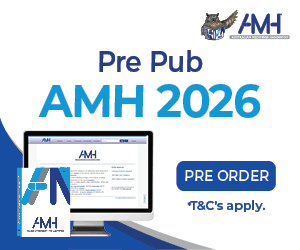Supporting equitable health outcomes in gender and sexually diverse people; how can we know if we don’t ask?
Gender and sexually diverse (GSD) people, including lesbian, gay, bisexual, transgender, queer/questioning, intersex, asexual/agender, and other groups (LGBTQIA+) experience barriers accessing equitable healthcare. This population also faces unique risks and health issues due to social determinants of health, including; sexuality, identity, relationships, and a long history of discrimination, marginalisation, and aggression both within and beyond healthcare.1,2
With sexual orientation and gender identity (SOGI) questions overlooked in the 2021 Australian census, there is limited official data and recognition of how many Australians identify as GSD.3 While it is difficult to establish a definitive figure, research suggests that GSD people could make up between 3.5% – 11% of the population.4,5
Globally, GSD populations experience disproportionate levels of mental health disorders (eg. anxiety and depression), psychological distress, and suicidal ideation.6 Transgender women, gay men, and bisexual men experience higher rates of HIV, and lesbian and bisexual women tend to report higher rates of overweight and obesity.6 Incorporation of SOGI questions aims to encourage more members of the community to self-identify and enable Australian health professionals to respond effectively to GSD Australians accessing healthcare.
When any person presents to a healthcare service or receives care, it is vital that staff can gain as clear a picture as possible to provide person-centred care. In the same way that a person’s physiological, anatomical, and hormonal characteristics are important considerations when planning and providing healthcare, gender and sexual identity are also important. This is because these factors are related to relationships, life conditions, housing, and physical and mental health risk factors. Implementing routine SOGI questions across all healthcare settings is important to monitor and respond to clinical presentations, laboratory value testing, risk factors, and understand the experiences, possible needs or preferences for care of GSD people who may be at any point along their transition journey.7,8
Applying routine SOGI questions as standard practice in health history assessments can be beneficial in various patient presentations. For example, cervical cancer rates are equal across lesbian, bisexual, and heterosexual women, however, lesbian and bisexual women are 4-10 times less likely to get routine pap tests to diagnose this condition.9,10 In this situation, knowing early on that a patient may be in an ‘at risk’ population for cervical cancer is a valuable tool for healthcare workers by helping them address barriers in routine Pap testing, improving engagement, and detecting cancers earlier, and support better treatment and equitable outcomes.
It is important to recognise that gender expression and presentation does not always provide an accurate insight into a person’s identity. SOGI information can be valuable when treating abdominal pain for a patient who expresses and presents as male but has female reproductive organs (eg. trans or intersex patients). This patient may need different examinations, tests, and care delivered in a person-centred, culturally safe manner compared to a cis-gendered man or woman presenting with the same complaint.11 Here, also consider how patients who identify and/or present as male might experience healthcare for endometriosis, cervical cancer, uterine fibroids, or even pregnancy.
Another example of how SOGI information is beneficial is when prescribing medications to trans patients.12 Some trans and gender diverse patients may have a history of self-prescribing gender-affirming medications through community members or online due to challenges in accessing treatments through mainstream means. Understanding and responding to this is vital to properly ascertain the risks of potential drug interactions and harms. The situations were SOGI can be beneficial are numerous and varied. By normalising routine SOGI data collection, healthcare staff can enhance accurate, individualised care, and better outcomes for all patients.
While the standard use of SOGI questions in health is an easy and cost-effective process that can be immediately implemented to help identify and address health disparities for GSD populations, there can be barriers. Qualitative research suggests that some staff feel that collecting SOGI information is irrelevant because they treat all patients the same.12 While ‘treating everyone the same’ could be seen as non-discriminatory, this often means treating everyone as cis-gendered and heterosexual.12 This can contribute to and perpetuate poorer engagement with healthcare and worse outcomes by making GSD people, their health risks, experiences, and outcomes invisible.12 Another barrier can be that some healthcare staff believe GSD patients may not be willing to disclose SOGI information, however when GSD people were asked, they understood the importance of their identity not being assumed.12 Having the opportunity to be asked in a sensitive and inclusive way can help build a trusting, therapeutic relationship and individualised care.12
While standardising the collection of SOGI information is a critical part of improving the equitability and inclusivity of healthcare, it must come as a part of a raft of changes to the way healthcare is delivered and the healthcare environment itself. Effective implementation of routine SOGI questions is not as simple as ticking a box on a form. At the best of times, a hospital can be scary and uncomfortable for any patient. Hence, environments need to feel safe for GSD people to disclose personal information, especially since GSD people have faced many decades of both overt and subtle marginalisation and discrimination.
Environments can be adapted in various ways to show alliance with GSD people, such as; displaying the LGBTQIA+ pride flag in waiting rooms, gender-neutral toilets, providing access to LGBTQIA+ resources, and ensuring all non-specific health recourses are inclusive.13 A recent study investigating the collection of SOGI information found that written forms could be preferred to verbal questioning in settings where therapeutic relationships were yet to be developed.1,14 It is also important to consider how intrapersonal interactions between staff and patients can be improved by addressing lack of GSD-specific education and knowledge gaps among healthcare staff. Lack of culturally sensitive education directly correlates with discrimination in healthcare settings and GSD people disengaging with healthcare services.15 GSD people also need to be involved in creating inclusive and culturally safe SOGI questions throughout healthcare settings.1
Routine collection of SOGI data is only one aspect of how healthcare could be improved to help support equitable experiences and outcomes for GSD people. Indeed, simply collecting data is useless if this data isn’t used to underpin improvements that result in more effective, appropriate care and outcomes. Nurses can be champions of improving the inclusivity and, therefore, effectiveness of healthcare for GSD people in their workplaces by advocating for and implementing changes that enhance awareness, access, and utilisation of SOGI data and culturally safe care.
The quantity and depth of research into providing person-centred, best-practice care to GSD people is improving. However, exclusion of SOGI questions is a barrier to any significant, real-world advancements. Without nationally collecting, incorporating, and acting upon SOGI data across population-level datasets such as the census, large population studies, and the entirety of healthcare, we will never know how many Australians identify as GSD, what Australian-specific health issues are experienced within GSD populations, or how healthcare staff can appropriately and effectively respond to this population’s needs and preferences as they change over time.
References
-
Kruse MI, Bigham BL, Voloshin D, Wan M, Clarizio A, Upadhye S. Care of sexual and gender minorities in the emergency department: a scoping review. Ann Emerg Med. 2021;79(2):161-212.
-
LGBTIQ+ Health Australia. Snapshot of mental health and suicide prevention statistics for LGBTIQ+ people. LGBTIQ+ Health Australia. 2021. Available from: https://d3n8a8pro7vhmx.cloudfront.net/lgbtihealth/pages/549/attachments/original/1620871703/2021_Snapshot_of_Mental_Health2.pdf?1620871703
-
Carrett J. LGBTIQ+ people are being ignored in the census again. Not only is this discriminatory, it’s bad public policy. The Conversation. 2021. Available from: https://theconversation.com/lgbtiq-people-are-being-ignored-in-the-census-again-not-only-is-this-discriminatory-its-bad-public-policy-165800
-
Lyons A, Rasmussen ML, Anderson J, Gray E. Counting gender and sexual identity in the Australian census. Aust Popul Stud. 2021;5(1):40-8.
-
Carman M, Farrugia C, Bourne A, Power J, Rosenberg S. Research matters: how many people are LGBTIQ? Rainbow Health Victoria. 2020. Available from: https://www.rainbowhealthvic.org.au/media/pages/research-resources/research-matters-how-many-people-are-lgbtiq/4170611962-1612761890/researchmatters-numbers-lgbtiq.pdf
-
Fredriksen-Goldsen KI, Simoni JM, Kim H-J, Lehavot K, Walters KL, Yang J, et al. The health equity promotion model: reconceptualization of lesbian, gay, bisexual, and transgender (LGBT) health disparities. Am J Orthopsychiatry. 2014;84(6):653-63.
-
Vivienne S, Hanckel B, Byron P, Robards B, Churchill B. The social life of data: strategies for categorizing fluid and multiple genders. J Gend Stud. 2021:1-15.
-
Haymer M, Bespalova N, Jennings L, Lau BD. Data collection and research. Springer International Publishing; 2020; 253-60.
-
Cahill S, Singal R, Grasso C, King D, Mayer K, Baker K, et al. Do ask, do tell: high levels of acceptability by patients of routine collection of sexual orientation and gender identity data in four diverse American community health centers. PLoS ONE. 2014;9(9):e107104.
-
Robinson K, Galloway K, Bewley S, Meads C. Lesbian and bisexual women’s gynaecological conditions: a systematic review and exploratory meta‐analysis. BJOG. 2017; 124(3):381-92.
-
Tollinche LE, Walters CB, Radix A, Long M, Galante L, Goldstein ZG, et al. The perioperative care of the transgender patient. Anesth Analg. 2018;127(2):359-66.
-
Kodadek LM, Peterson S, Shields RY, German D, Ranjit A, Snyder C, et al. Collecting sexual orientation and gender identity information in the emergency department: the divide between patient and provider perspectives. Emerg Med J. 2019;36(3):136-41.
-
Vermeir E, Jackson LA, Marshall EG. Barriers to primary and emergency healthcare for trans adults. Cult Health Sex. 2018;20(2):232-46.
-
Haider AH, Schneider EB, Kodadek LM, Adler RR, Ranjit A, Torain M, et al. Emergency department query for patient-centered approaches to sexual orientation and gender identity. JAMA Intern Med. 2017;177(6):819.
-
Elertson K, McNiel PL. Answering the call: educating future nurses on LGBTQ healthcare. J Homosex. 2021;68(13):2234-45.
Authors:
Chantal Hunter is a third-year registered nursing student and an inaugural Rosemary Bryant AO Research Centre Summer Research Scholar.
Rhys Wright is a Senior Pharmacy Technician and Pharmacy Service Coordinator, the Royal Adelaide Hospital, Central Adelaide Local Health Network.
Casey Marnie and Micah DJ Peters PhD work at the National Policy Research Unit (Federal Office), Australian Nursing and Midwifery Federation (ANMF) and the University of South Australia, Clinical and Health Sciences, Rosemary Bryant AO Research Centre








